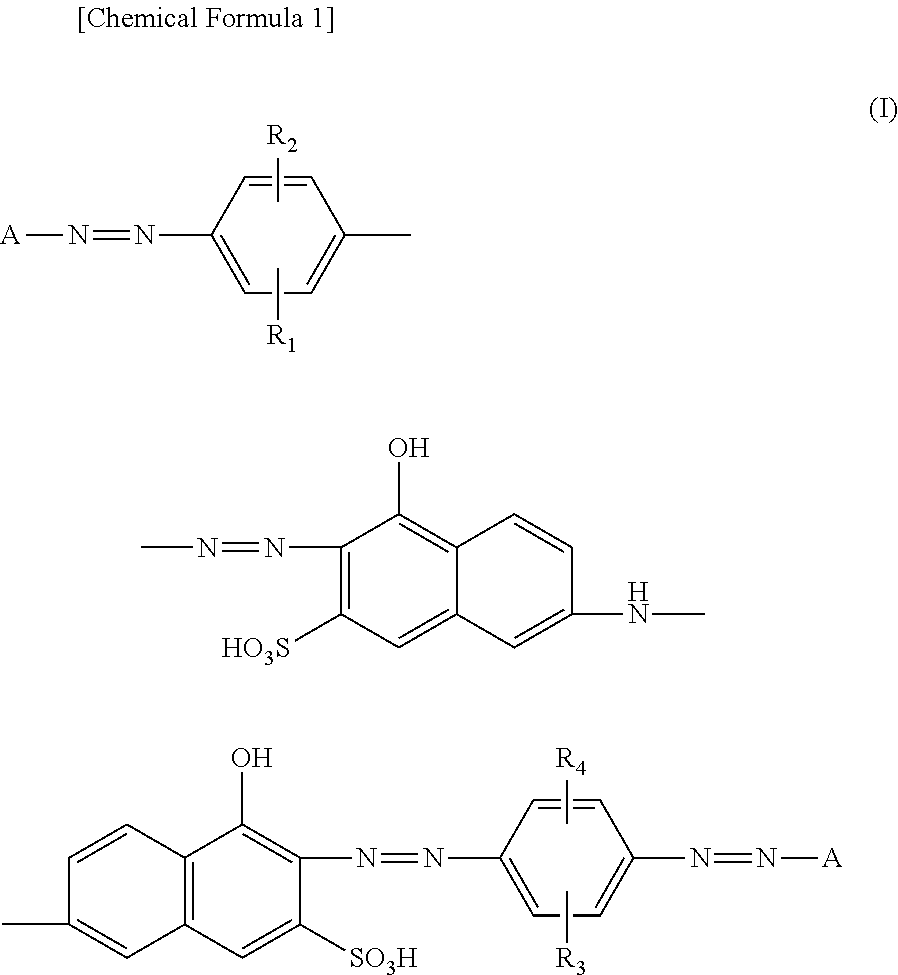Dye-Based Polarizing Element And Polarizing Plate
a polarizing element and dyeing technology, applied in the field of dyeing polarizing elements and polarizing plates, can solve the problems of low light stability and low light stability, and achieve the effect of good dyeing affinity and good polarizing property
- Summary
- Abstract
- Description
- Claims
- Application Information
AI Technical Summary
Benefits of technology
Problems solved by technology
Method used
Image
Examples
synthesis example 1
[0059]32.5 Parts of 2-aminonaphthalen-4, 8-disulfonic acid (conventional name: C acid) were dissolved in 145 parts of water, and added to 140 parts of water containing 26 parts of 35% hydrochloric acid, and were added to 6.9 parts of sodium nitrite at 15 to 20° C., and the mixture was diazotized over one hour. Then, an aqueous solution containing 13.7 parts of para-cresidine and 17.5 parts of 35% hydrochloric acid was added, and coupling was performed at 20° C. over 4 hours while keeping pH to 3.0 to 3.5 with sodium acetate, until para-cresidine was not recognized with the spot test. Then, to the obtained aminoazo compound, 21.4 parts of 35% hydrochloric acid were added, and 6.9 parts of sodium nitrite were added at 10° C., and second diazotization was performed at 15 to 20° C. over 2 to 3 hours. Then, this was added to an aqueous solution having 31.5 parts of N,N-bis(1-hydroxy-3-sulfo-6-naphtyl) amine (conventional name: di-J acid), 125 parts of water and 11 parts of soda ash, and ...
example 1
[0060]A polyvinyl alcohol-based resin film having a saponification degree of 99% or more and a thickness of 75 μm (VF series manufactured by KURARAY CO., LTD.) was dipped into 40° C. warm water for 2 minutes to perform a swelling treatment. The swelling-treated film was dipped into a 45° C. aqueous solution containing 0.05 weight % of pigment represented by compound 2 and 0.1 weight % of sodium tripolyphosphate, to perform adsorption of the dyes. The film, adsorbed with the dyes was washed with water, and after the washing, boric acid treatment was performed with a 40° C. aqueous solution containing 2 weight % of boric acid for 1 minute. The obtained boric acid-treated film was treated in a 55° C. aqueous solution containing 3.0 weight % of boric acid for 5 minutes while being stretched to 5.0 times. Washing was performed for 15 seconds with 30° C. water with keeping the tension state of the obtained, boric acid-treated film. The dry treatment was immediately performed for the obtai...
PUM
 Login to View More
Login to View More Abstract
Description
Claims
Application Information
 Login to View More
Login to View More - R&D
- Intellectual Property
- Life Sciences
- Materials
- Tech Scout
- Unparalleled Data Quality
- Higher Quality Content
- 60% Fewer Hallucinations
Browse by: Latest US Patents, China's latest patents, Technical Efficacy Thesaurus, Application Domain, Technology Topic, Popular Technical Reports.
© 2025 PatSnap. All rights reserved.Legal|Privacy policy|Modern Slavery Act Transparency Statement|Sitemap|About US| Contact US: help@patsnap.com



